The $30 billion contradiction: why 70% of users curse at chatbots—yet 75% are satisfied.
Nearly 70% of people have sworn at a chatbot out of frustration, yet 75% report satisfaction with their most recent interaction. One in four would trust a Magic 8-Ball over AI support, while businesses save up to 30% on operational costs using these same technologies.
This isn’t just a customer service story—it’s a $30 billion market contradiction that reveals the true state of AI support in 2025.
Our latest comprehensive study surveyed over 1,000 internet users and 300 business owners, uncovering the stark reality behind chatbot implementations. What we found challenges many things people assume about the customer service industry.
The bottom line?
The difference between helpful and hopeless chatbots isn’t the technology—it’s the strategy behind it.
Key Findings That Will Change How You Think About AI Support
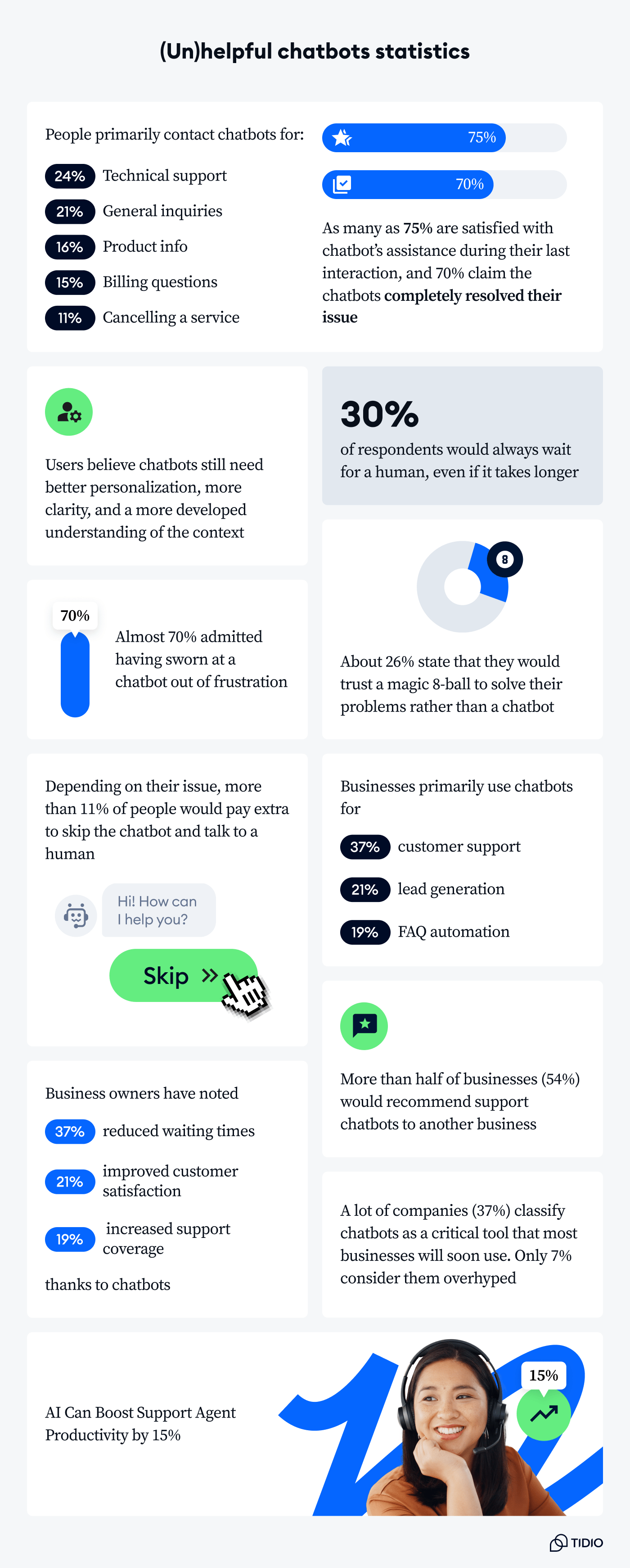
Frustration Factor
- As many as 70% of users have sworn at a chatbot out of frustration—yet most don’t see this as the reason not to purchase from a company
- Around 26% would trust a Magic 8-Ball to solve their problems rather than a chatbot
- About 30% prefer waiting for humans even when chatbots are available immediately
- More than 11% would pay extra to skip the chatbot and talk to a human
Success Metrics
- Around 75% of users are satisfied with their most recent chatbot interaction
- As many as 70% of people had their issues completely resolved by chatbots
- More than half of businesses (54%) would recommend support chatbots to other companies
- Chatbots reduce operational costs by more than 30%
Business Impact
- AI can boost support agent productivity by 15%
- AI automation resolves tickets 52% faster than traditional methods
- Chatbots can help automate up to 70% of customer requests
- About 37% of companies classify chatbots as a critical tool most businesses will soon use
- Only 7% of people who have interacted with support chatbots consider them overhyped
What People Actually Use Chatbots For
Our data reveals the top reasons people contact chatbots are:
- Technical support (24%): Help and advice about products
- General inquiries (21%): Basic information requests
- Product information (16%): Features, pricing, availability
- Billing questions (15%): Account and payment issues
- Cancelling a service (11%): Account closure requests
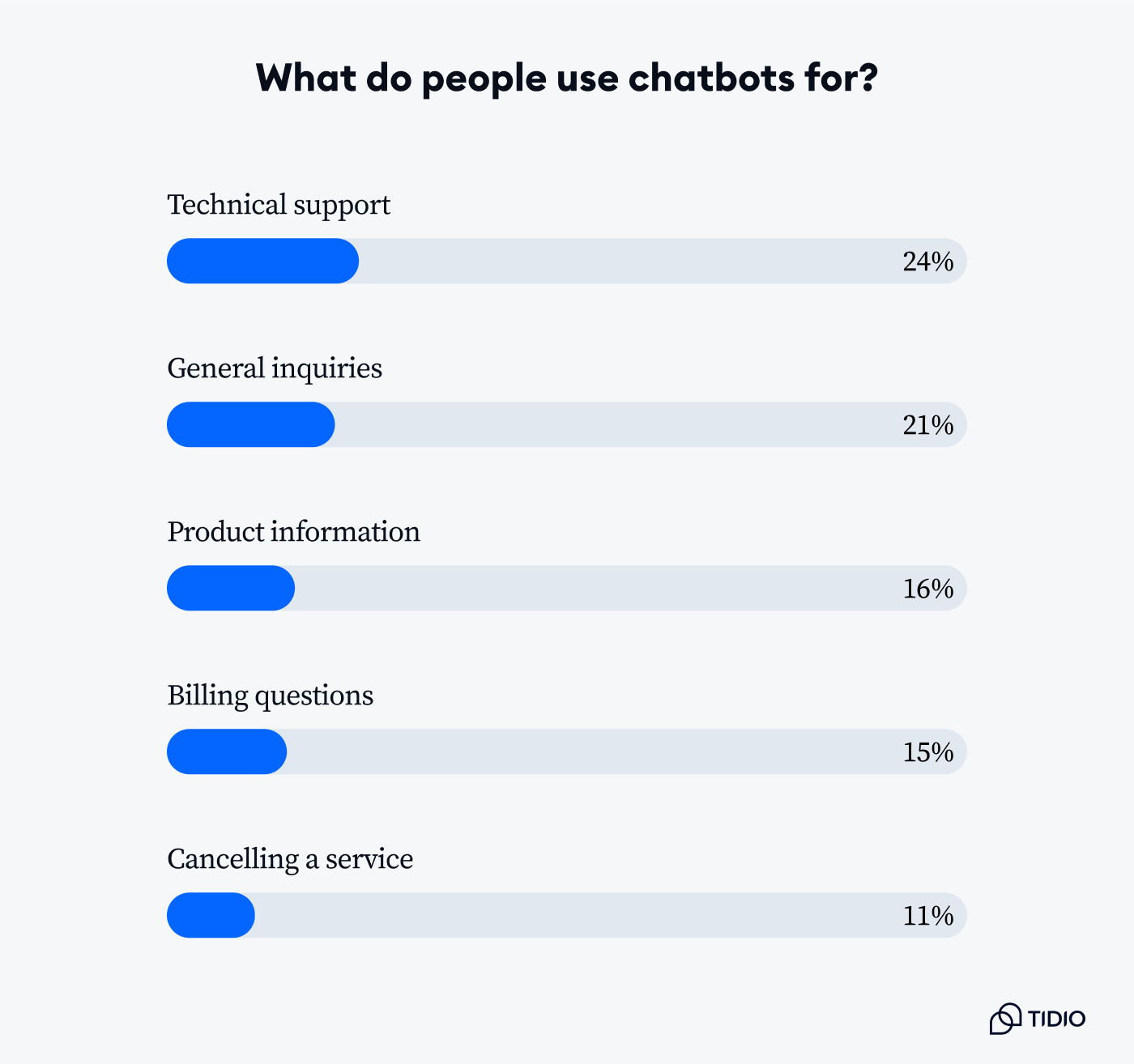
Business Perspectives: Why Companies Implement Chatbots
Business owners told us they primarily use chatbots for:
- Customer support (37%): All kinds of assistance to customers
- Lead generation (21%): Converting visitors to prospects
- FAQ automation (19%): Handling repetitive questions
- Order tracking (10%): Easily checking order status
- Booking/appointments (9%): Hassle-free reservations
- Other (4%)

Here are the main benefits of customer support chatbots, according to businesses that use them:
- Reduced waiting times (22%)
- Improved customer satisfaction (20%)
- Increased support coverage (18%)
- Reduced support team workload (16%)
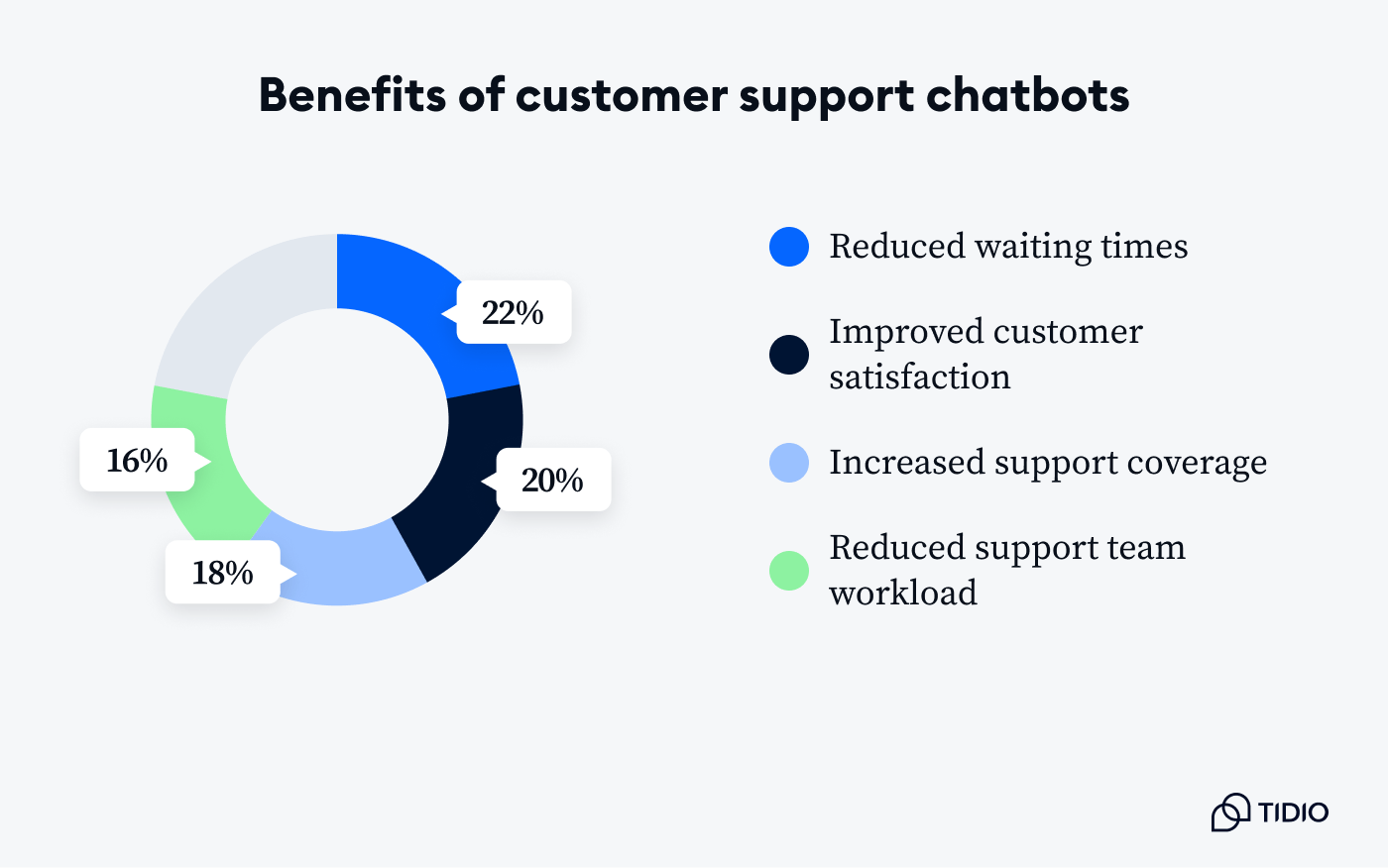
At present, about 90% of conversations are handled by our chatbot, Lyro, and in the vast majority of cases the responses have been perfect. These responses are audited daily to ensure that the correct responses and information is given. My biggest fear of AI hallucination seems to have been unfounded, as even intentionally attempting to get Lyro to provide false information has been unsuccessful.

Let’s dig into what allows a chatbot to bring such results, and what makes them your best helpers.
What makes a chatbot helpful?
When customer support chatbots work well, users barely notice they’re talking to AI. In fact, a well-designed chatbot can streamline issue resolution, reduce wait times, and offer fast, accurate assistance. All these without the hold music. And believe us, users appreciate these things more and more.
Here’s what sets actually helpful chatbots apart:
- Quick and accurate responses: People need efficiency. Chatbots that can instantly provide relevant information or guide users through common issues save time and reduce frustration.
- Clear, human-like language: Bots that avoid jargon and communicate in a natural, conversational tone make the interaction feel more intuitive and less robotic.
- 24/7 availability: One of the biggest advantages of chatbots is around-the-clock support. Customers appreciate being able to get help outside of normal business hours.
- Smart routing to human agents: Helpful chatbots know their limits. When a situation becomes too complex, a smooth handoff to a human agent ensures a great user experience.
- Personalization and memory: Bots that remember user preferences and their past issues can provide more tailored support. This inevitably leads to higher satisfaction.
- Task automation: Chatbots should smoothly handle repetitive tasks so agents can focus on more complex issues that require human empathy and critical thinking.
- Consistency: Unlike human agents who may vary in responses, chatbots offer consistent answers, ensuring customers receive accurate information every time.
When done right, chatbots don’t just answer questions. They enhance the overall customer experience, attract leads, turn visitors into paying customers, and help increase retention. Instead of being a frustrating hurdle, they become a valuable first point of contact for resolving everyday issues quickly and conveniently.
What makes a chatbot hopeless?
The truth is, not all chatbots are created equal. While some enhance the customer experience, others do the opposite, turning simple problems into drawn-out, infuriating interactions. A poorly designed chatbot can feel like a brick wall rather than a support tool. No wonder many of our respondents would rather pay money than talk to a chatbot.
Here’s what makes a chatbot more of a bother than a help:
- Scripted, rigid responses: When a chatbot can only handle exact keyword matches or predefined paths, it quickly becomes frustrating for users trying to explain unique or nuanced problems.
- Lack of context awareness: Hopeless chatbots can’t “remember” what a user just said or understand the flow of a conversation, leading to repetitive questions and dead ends.
- No option to talk to a human: Forcing users to stay in an endless chatbot loop without the ability to escalate to a real person is one of the biggest complaints among users.
- Unhelpful or irrelevant answers: If a bot constantly misinterprets the question or provides generic responses that don’t match the issue, it quickly erodes trust.
- Overuse of technical or robotic language: A chatbot that sounds more like a broken command line than a helpful assistant makes users feel like they’re solving a puzzle instead of getting support.
- Too many dead ends: A bot that simply says “I didn’t understand that” or offers no next steps leaves users stranded—and often angry.
- Fails to complete basic tasks: When a chatbot can’t help with common support issues like order tracking, billing, or password resets, users are left wondering what the point of it is.
In short, a hopeless chatbot feels like a barrier rather than a bridge. It creates more problems than it solves, and it can seriously damage a customer’s perception of the brand behind it.
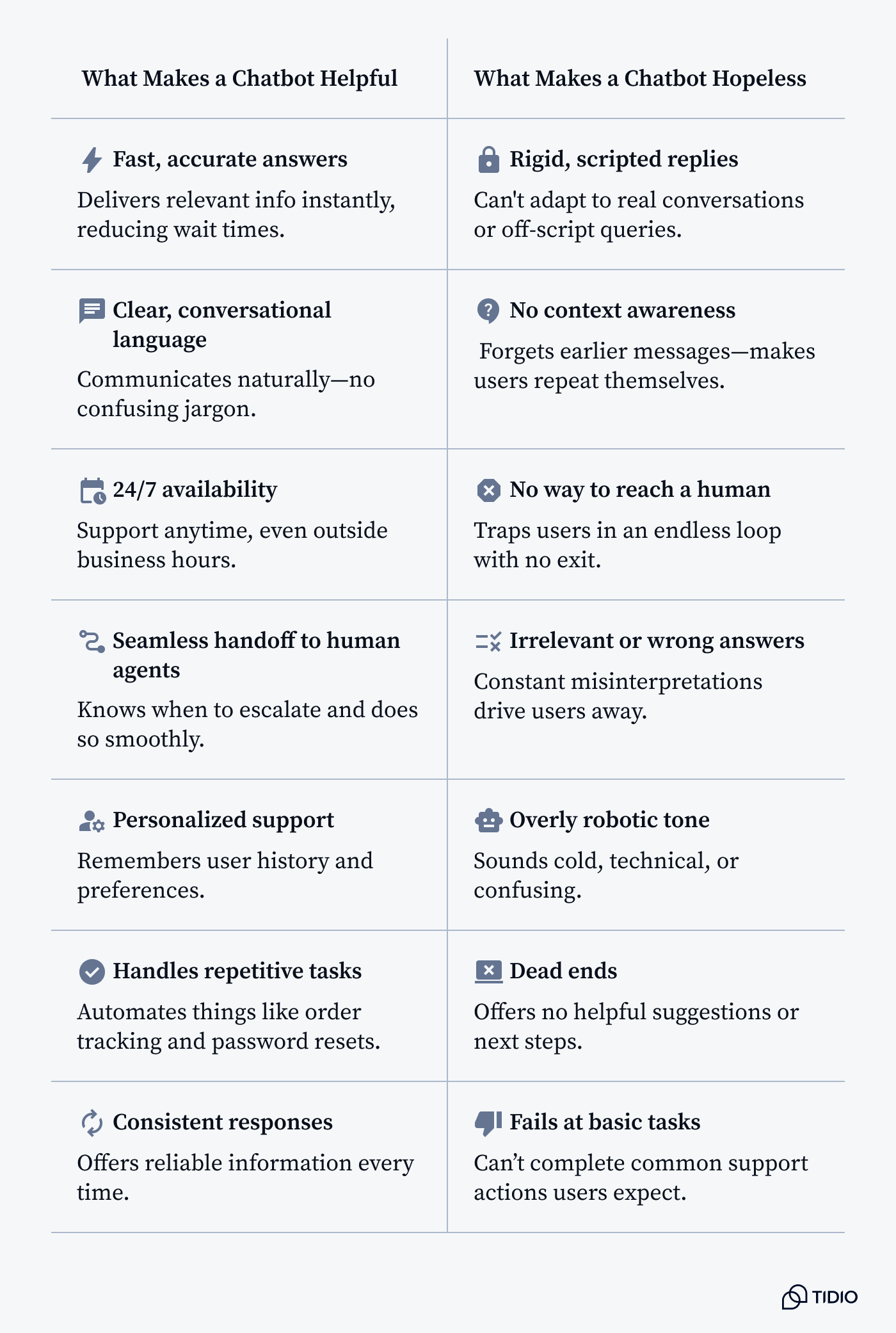
Key statistics that tell the real story
- As many as 75% of users are satisfied with their latest chatbot interaction
Most users are satisfied with recent chatbot experiences, showing that well-designed bots can meet expectations and resolve issues. This underscores the importance of continuous improvement in chatbot design to maintain and enhance user satisfaction.
- More than 70% of users have their issues fully resolved by chatbots
Chatbots are not just initial points of contact; they are increasingly capable of resolving customer issues entirely. This efficiency can lead to reduced wait times and improved customer experiences, highlighting the potential of chatbots to handle a wide range of inquiries without human intervention.
- About 30% of users prefer waiting for a human agent, even if it takes longer, and 11% would pay extra to skip the chatbot and talk to a human
Despite advancements in chatbot technology, a notable portion of users still prefer human interaction, especially for complex or sensitive issues. This preference emphasizes the need for businesses to provide seamless transitions between chatbots and human agents
- As many as 70% of users have sworn at a chatbot out of frustration
High levels of user frustration point to shortcomings in chatbot interactions, such as misunderstandings or unhelpful responses. This one stings, so addressing these pain points through improved natural language processing and user experience design is crucial for enhancing customer satisfaction.
- About 26% of users would trust a magic 8-ball over a chatbot
Chatbots do get a bad rep. There is still a pretty significant trust gap between users and chatbot technology. It serves as a call to action for developers and businesses to build more reliable, transparent, and user-friendly chatbot systems to foster greater trust and reliance among users.
- Chatbots reduce operational costs by up to 30%
It’s hard to deny that chatbots help companies save money. Not only do they bring in new customers and help retain them, but also slash costs per chat by a third. Chatbots automate repetitive tasks like FAQs and returns, enabling businesses to scale support without increasing staff. Operating 24/7, they deliver continuous service at a fraction of human costs.
- AI assistance can increase support agent productivity by 15%
AI assistance can boost support agent productivity by 15%, especially by handling repetitive tasks and surfacing relevant information instantly. However, the best outcomes come when AI works with humans—not instead of them. While 6.8% of companies have reduced headcount and 55.7% have slowed hiring due to AI, human agents remain essential. Combining AI efficiency with human empathy, judgment, and trust-building, the traits AI can’t fully replicate, is the smartest way for companies to enhance service quality.
- AI automation helps resolve tickets 52% faster than traditional methods, and automate up to 70% of customer service
AI-powered systems drive quicker resolutions and improve overall customer satisfaction. Solutions like Tidio’s Lyro AI Agent exemplify this leap in efficiency, reducing average response times to under 6 seconds. Lyro can also automate up to 70% of customer requests, with businesses reporting automation rates as high as 90% during peak efficiency. This kind of performance not only shortens wait times but also frees up human agents to focus on more complex, high-value interactions.
AI vs. human support: which is actually better?
The answer isn’t as simple as choosing one over the other—because both AI and human agents excel in different areas of customer support. AI brings speed, consistency, and scalability, while humans offer empathy, critical thinking, and emotional nuance. When used together, they create a hybrid support model that can dramatically improve both efficiency and customer satisfaction.
AI is better for handling repetitive queries that require instant responses 24/7 and managing multiple conversations simultaneously. It’s ideal for answering FAQs, or pulling up order and account data. AI never takes breaks, doesn’t get tired, and can resolve many routine issues simultaneously.
Humans are better for complex, sensitive, or emotionally charged interactions, e.g., escalations, complaints, or unusual use cases that don’t follow a script. People still prefer speaking with a human when they feel misunderstood or frustrated, and no algorithm can match the empathy and creativity of a skilled human agent.
Ultimately, the most effective customer support doesn’t rely on either AI or humans alone. It combines the best of both.
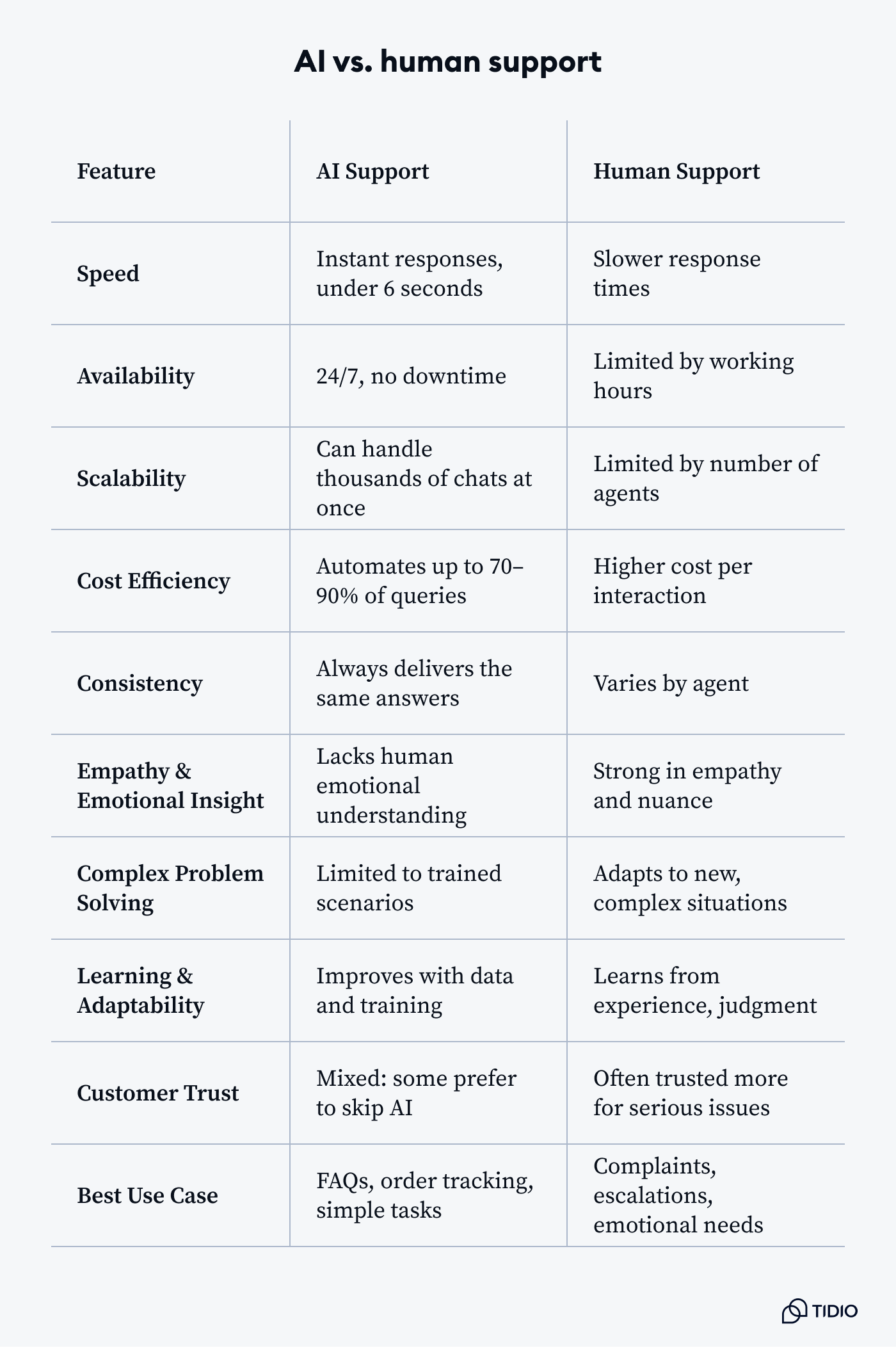
Will chatbots replace human support agents?
The rapid advancement of AI in customer service has sparked discussions about the potential for chatbots to replace human support agents. Many are scared to lose their jobs, while some remain unbothered.
The truth?
The hybrid approach wins: while AI chatbots have proven effective in handling routine inquiries, the complete replacement of human agents remains unlikely in the near future. Still, humans need to be able to use AI efficiently and make it their assistant, not enemy.
Chatbots can significantly improve efficiency and reduce costs by managing high volumes of simple requests, but they still fall short in areas that require empathy, complex problem-solving, and contextual understanding. Customers often prefer to interact with humans for sensitive or nuanced issues, or simply because they are still not so trusting of bots.
Rather than a full replacement, most industry leaders see AI as a complement to human agents. Many companies are specifically adopting intelligent AI agents as co-pilots, designed to automate repetitive tasks and assist, rather than displace, human employees. The future of customer service lies in a hybrid model where AI handles simple tasks, boosting efficiency, while humans provide the empathy and expertise machines can’t match.
How to use AI for customer support (without losing customers)

Integrating AI into your customer support system can be a game-changer.
But—
Only if it’s done thoughtfully.
AI should enhance your service, not frustrate your users. To ensure your AI deployment improves customer experience rather than damages it, you should consider a solution that blends the speed and scale of automation with the nuance and empathy of human support.
- Focus your AI efforts where they’ll have the most impact with the least risk
Tasks like order tracking, password resets, basic account inquiries, and shipping information are repetitive—making them perfect for automation. These queries make up a large percentage of inbound support volume, and AI can handle them quickly and accurately. Automating these common requests gives your human agents more time to focus on complex issues while giving customers the instant answers they expect.
- Make escalation to a human easy and obvious
One of the biggest complaints users have about chatbots is being stuck in a loop with no way to reach a real person. Avoid this by offering a clear and easy way to connect with a human agent when needed. Don’t hide this option behind multiple prompts or assume your AI can always solve the issue. A fast, seamless handoff builds trust. It also often prevents customers from abandoning the interaction out of frustration.
- Use AI to assist your support agents, not replace them
Give your team tools like AI-powered response suggestions, knowledge retrieval, and conversation summarization. These features help agents resolve issues faster and more accurately, particularly for newer team members who may still be learning. When AI acts as a co-pilot, it boosts productivity and job satisfaction, while maintaining the human touch that customers still value.
- Train your AI with real-world data and refine continuously
Your AI is only as good as the data it’s trained on. Use actual support transcripts to train your models so they reflect the language and tone your customers use. Regularly review chatbot performance, identify where drop-offs or misunderstandings occur, and use that feedback to improve. AI is not a fire-and-forget solution—it requires constant tuning to stay relevant and effective.
- Match the tone and personality of your brand
A generic or robotic chatbot can feel impersonal, even if it solves the problem. Craft your bot’s tone of voice to reflect your brand—whether that’s friendly and casual or professional and efficient. This consistency ensures customers have a cohesive, thoughtful experience, no matter who (or what) is answering.
- Set clear expectations
Be transparent with users that they’re interacting with a chatbot and let them know what it can and can’t do. If your AI can only help with certain issues, make that clear up front. Customers are far more forgiving when they know what to expect—and disappointed when they feel misled.
- Don’t over-automate
Just because you can automate something doesn’t mean you should. For emotionally charged, complex, or high-stakes issues (like billing disputes or complaints), human empathy and judgment are irreplaceable. The best support strategies know when to use AI—and when to step aside and let people take over.
Here is a checklist for companies to keep the pulse on their chatbot performance, both before and after launching it:
Before launch:
- Test with real customers, not just internal teams
- Ensure human escalation works seamlessly
- Train staff on hybrid workflows
- Set up monitoring and feedback systems
After launch:
- Weekly performance reviews for the first month
- Monthly customer satisfaction surveys
- Quarterly strategy adjustments based on data
- Annual comprehensive review and upgrade
When deployed strategically, AI can transform your support operations—handling simple tasks, speeding up resolution times, and empowering your human team. But the best outcomes always come from a hybrid model that respects the strengths of both technology and human connection.
Chatbots aren’t the problem — bad chatbots are
Customer frustration with chatbots often stems not from the idea of AI support itself but from poor implementation. A chatbot that misunderstands simple questions and loops users in endless menus doesn’t just disappoint. It also actively erodes trust in the brand.
But the truth is, not all chatbots are created equal. When designed thoughtfully and powered by the right technology, AI can deliver fast, accurate, and even enjoyable support experiences. According to a report by Zendesk, 72% of customers expect immediate service, and AI-powered chatbots are often the only way to deliver that speed at scale. Yet, many companies fall short due to outdated or rule-based bots that lack true understanding or adaptability.
That’s where solutions like Lyro AI make a difference. Lyro is not a basic script-based chatbot. It’s a conversational AI agent built to understand context, resolve up to 70% of requests automatically, and respond in under 6 seconds. Unlike generic bots, it doesn’t just deflect tickets but solves them, delivering the kind of experience customers expect in 2025.
Our survey perfectly reflects the state of affairs. The reality is, people don’t hate chatbots. They hate bad ones. With the right AI, support can be faster, smarter, and more human than ever.
Sources:
- 35 customer experience statistics to know for 2025
- The Future of Chatbots: 80+ Chatbot Statistics for 2025
- Tidio’s AI Agent Lyro Achieves Industry-Leading Customer Support Resolution Rates, Outperforming Intercom
- Gecko Hospitality Reaches 90% Customer Service Automation
- Chatbot Market Expected to Reach USD 31.38 Billion by 2030, Driven by AI Advancements and Automated Customer Support
Methodology
For this study about helpful and hopeless chatbots, we collected answers from 1300 respondents. We used Amazon Mechanical Turk and Hotjar.
They had to answer 18 questions and 12 questions respectively, the majority of which were multiple choice. The survey had an attention check question.
Fair use statement
Has our research helped you learn more about customer support chatbots? Feel free to share statistics from this study. Just remember to mention the source and include a link to this page. Thank you!

